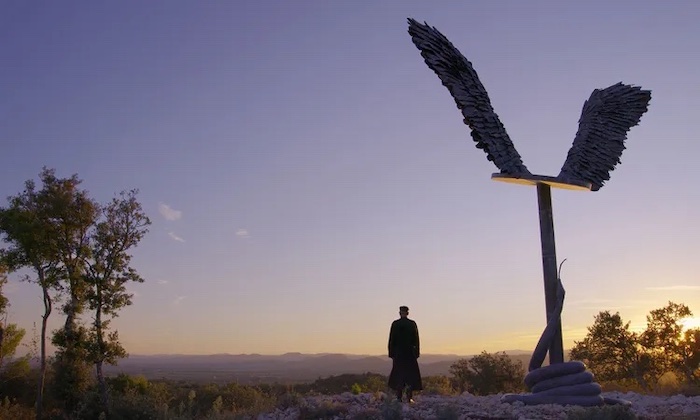
Wim Wenders’ portrait of Anselm Kiefer sketches in several biographical details of the septuagenarian Austrian-German multimedia artist, but for the most part dwells on his work and what that work means in the world. Consequently, there are holes in my understanding of Kiefer that would probably require a bit of in-depth reporting, such as how does he afford the cavernous warehouse-ateliers he uses as workshops—he uses bicycles to get from room to room—not to mention the staff they require. Anyone familiar with Kiefer’s work understands that the most apt adjective to describe it is “enormous,” with some mixed media paintings taking up entire walls and requiring movable platforms to work on, not to mention the vast outdoor installations. I know it’s crass to talk about the financial aspects of how art comes into being, but the documentary makes clear that Kiefer’s work is not designed as decoration, and the political subtexts, if not the overt content, is meant to be discomfiting. The movie made me appreciate the art and therefore I want to know more about the commerce.
Wenders’ concern is the way Kiefer incorporates into his art 20th century German history, whose depiction is referred to by one reporter as an “open wound.” Using relatives of the artist and the director to play him at various times in his life, Wenders dramatizes how his environment—he moved from Austria to Germany after the war when he was a boy—affected his creative impulses. An excellent draftsman as a young man who used some prize money to make a pilgrimage to study the life and work of Van Gogh, Kiefer eventually confronted his heritage with an infamous series of staged photos of himself giving the Hitler salute at various European landmarks related to Nazism as a “protest against forgetting.” And he didn’t stop there. “Germans have always had a problem with it,” he says of his art, which just became bigger and bigger over the years. Some of his museum installations are so large they have to be cut a certain way in order to allow people to enter and leave the room. Wenders doesn’t show the mechanical process of the installations, though he does show Kiefer working on parts of individual pieces. He also inserts archival footage, mainly of ruins after the war, sometimes with children playing in them, without comment as counterpoint to some of Kiefer’s “landscapes,” which can be forbidding, but more in what they suggest than what they show (“This is a scene where tanks have already driven through”).
Kiefer’s spiritual indebtedness to the Jewish poet Paul Celan and his obsession with the Nazi-tolerant philosopher Martin Heidegger are covered mainly to provide points of influence on his thinking but come across as arcana in relationship to the art we see. Wenders obviously thinks we should draw our own conclusions, and he’s right in thinking that difficult art can’t be properly explained in a 90-minute film, but Kiefer’s work is so confrontational that I think the viewer can stand a bit more contextual explication without feeling as if they’re being led by the hand. Given that portions of the doc are filmed and presented in 3D, some of this stuff is bound to be overwhelming (the press screening I attended was in 2D), and in that regard you will probably want to know as much as you can about what drove the artist to create it.
In German and English. Now playing in Tokyo at Toho Cinemas Hibiya (3D, 050-6868-5068), Shinjuku Musashinokan (03-3354-5670), Human Trust Cinema Shibuya (3D, 03-5468-5551).
Anselm home page in Japanese
photo (c) 2023 Road Movies
